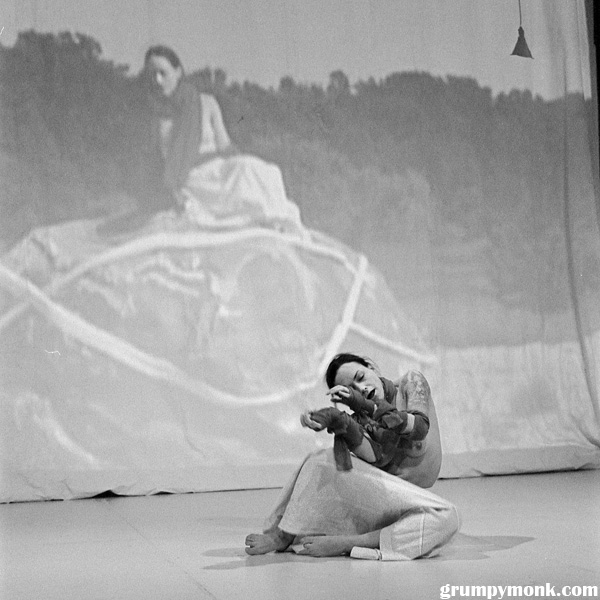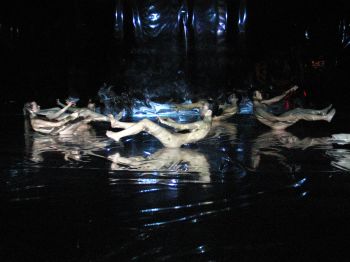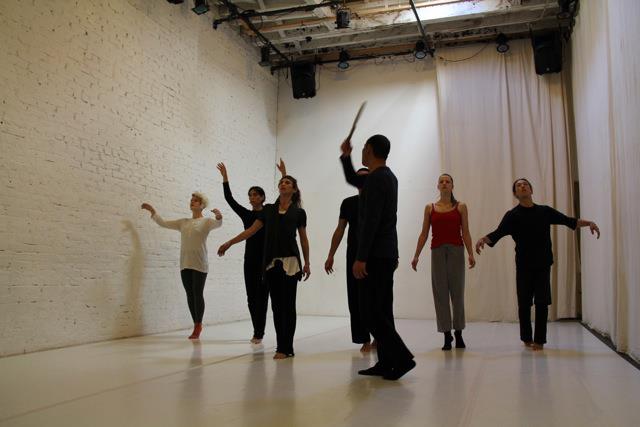cave
neighborhood: williamsburg | space type: performance / art space | active since: 1996 | links: website, tumblr
CAVE, led by video artist/curator Shige Moriya and theater-dance director/dancer Ximena Garnica, is a tiny experimental and alternative art space, one of the longest-running in Williamsburg. Their stated goal is to “maintain an environment that attracts, provokes and supports exchange, generative confrontation and collaboration among emerging and established artists and audiences from diverse cultures and artistic backgrounds.” To this end they hold workshops, performances, commissions, and exhibits, both solo and collaboratory, along with annual festivals and artist-in-residency programs.
In the nineties and early aughts, the space had a broader scope, including visual arts of all kinds, music, dance, and other types of performance. In the last decade, CAVE has refined its focus, and now primarily presents and nurtures innovative varieties of dance and performance art, and has become one of the New York hubs for butoh, a Japanese conceptual dance movement.
Many of the performances and events in the biennial New York Butoh Festival are held here, and CAVE jointly established New York Butoh-Kan, an ongoing intensive training program that brings butoh masters from Japan to give classes and seminars in Brooklyn.
CAVE also offers short- and long-term artist-in-residence programs, and hourly rentals of its dance studio.
Q&A with Bryan, a former CAVE artist-in-residence
brooklyn spaces: Why is it called CAVE, and
what is the history of the space from your perspective?
Bryan: Shige Moriya started the space back
in 1996 with a few friends. He is the only originator who still lives there.
Shortly thereafter he met Ximena, and their loving relationship has conceived
of, sponsored, spawned, incubated, and nurtured innumerable beautiful works. I
think it was called CAVE just because the space is rather cave-like on the
inside. Living there, I liked to fancy it like how I imagined the inside of the
Batcave works, you know: over here is where we work out antidotes to
poisons, over there is the machine that keeps profiles of the world’s most
dangerous people, this is the bulletproofing cloakroom, etc. I should really
encourage them to install a firepole.
brooklyn spaces: What drew you to CAVE, and
how long did you live there?
Bryan: I saw a performance there many years
ago and was mesmerized. Yuko Kaseki took my breath away, and the images of her
movements became scorched onto my brain forever. Much later, I was working a
boring office job and had spare time outside of my musical endeavors, and was
just feeling under-spun, so I answered a Craigslist add for a job with CAVE. It
was for a very lowly sounding position, a stamp-licker or something, which was
what made me think I could handle it. But after I interviewed with Ximena and
Shige, they made me the Workshop Director for the 2007 New York Butoh Festival.
This meant that I was responsible for the registration and attendance of over a
hundred dancers from around the world, as well as accounting for thousands of
dollars of participants’ money and generally making sure the workshops
went smoothly. It was daunting, but Ximena and Shige giving more confidence to
me than I would have given to myself really helped me to grow. I wound up
living at CAVE two separate times, for about eight months each time, between my
two trips to Indonesia.
brooklyn spaces: How did CAVE help you with
your art?
Bryan: CAVE helped me with my art inside
and out and everywhere in between. Aesthetically, learning about butoh,
studying with masters from Japan, interviewing them for my radio program,
watching it manifest, soundtracking choreographies… All of these things
deepened my aesthetics and helped expand how I understand living and breathing.
Meeting people was the other most remarkable impact of living and working
through CAVE. One worker there, Claire Duplaniere, told me about a scholarship
in Indonesia, and now I am living here on my third scholarship. Another
artist-in-residence, Yana Km, found out about one of the same scholarships
through me, and now she’s living here too. So things like this have really
been life-changing. And it is cyclical. I had the privilege of working with Yuko
Kaseki, the first butoh dancer I ever saw perform and still one of my
very favorites, on a video I filmed with my band, Bloody Panda. I helped
organize a music festival with CAVE two years ago, and artists who met that day
are still making recordings together in different contexts. It’s thrilling
to think about the potential that such a collective provides.
brooklyn spaces: What were the best and
worst things about living there?
Bryan: Living there really makes you become
hyper-conscious of how you conduct yourself. You’re a worker and a friend,
helping to create art while helping the functioning of this
non-profit collective. Personalities can clash. It taught me a lot about how
to keep everyone’s best intentions in mind and to always try to show mine,
especially after making mistakes.
brooklyn spaces: How does the community
respond to CAVE?
Bryan: In an amazing way. CAVE’s
loyal audience is responsible for the fact that just about every
performance there sells out. I remember once when I was running the box office,
I had to console people who hadn’t made reservations to a sold-out
performance. “It’s a nice sunset over there on the East River,
though, yeah?” Maybe they wanted to punch me, but instead they smiled.
***
Like this? Read about other performance spaces: Chez Bushwick, South Oxford Space, Bushwick Starr, The Muse, Cave of Archaic Remnants




